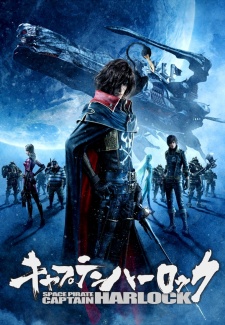
A few weeks ago my dad, a sci-fi and CGI junkie, walked into my room saying he found an anime movie called Space Pirate Captain Harlock on Netflix. I calmly explained to him that a) this is a sequel movie to a much longer TV show, and b) having come out in the 80’s it is not exactly the pinnacle of modern CGI. He fired it up anyway, and much to my surprise there was Captain Harlock in a standalone story, rendered in beautiful Final Fantasy-esque CGI that felt almost too real. In fact with the Hollywood plot and pacing, combined with subtitles that reimagined the anime-style Japanese as the typical dialogue from a Western action blockbuster, the film felt entirely unlike an anime experience. While obviously less packed with substance than either the original series or the more well-known anime sci-fi works—as the end credits rolled we set up a time to watch Ghost in the Shell together—it felt like a Hollywood sci-fi action show done right, action-packed and paced to support a rapidly changing story without being overbearing, and with stunning visuals to boot.
To anime fans, the story of a young man caught in the middle of political tensions between an entrenched Earth-obsessed government and the swashbuckling rebels who fight their cult-like behavior may seem all too familiar (e.g. the Mobile Suit Gundam franchise, for one). The focus of Space Pirate Captain Harlock is not the titular space pirate at all, but rather a newcomer on board the Arcadia named Yama, who seeks a life of freedom on board the immortal pirate ship away from humanity’s last crumbling vestiges strewn across the galaxy. His newfound compatriots end up in conflict against Yama’s brother Ezra, a high-ranking official of the galaxy’s central government, the Gaia Sanction. The government reveres Earth, keeping everyone away from its fragile beauty, but as Harlock and the Arcadia go on a vaguely-codified quest to go back in time to a more idyllic period in humanity’s history, the lies and past sins on both sides come into view, causing Yama to change his alliance back and forth to make moral sense of the whole affair.
Many scenes in the film seem specifically designed with a Hollywood audience in mind. Yama and his superior officer Kei descend onto a planet to set up a device on Harlock’s orders, only for the Earth to crumble around them and result in a tense ten-minute fight for survival. The space battles between the Arcadia and the Gaia Sanction are packed with superpowered lasers, holograms, and everything else that could show off the animation budget and fight choreography. By contrast, there are some tropes that end up as simple red herrings. Kei is clearly set up to be Yama’s love interest as his no-nonsense female superior, and yet she ends up just being a strong commanding officer. Another woman from Yama’s past, his brother’s wife, could have been used as a moral deus ex machina used to quell the two fighting brothers, but instead she widens their rift and is ultimately used in a way that may shock Western audiences. The ending is straight from the Hollywood playbook of symbolic finales, but at least that isn’t made overtly obvious until the last few scenes.
The reason to go see Space Pirate Captain Harlock is about the same as for Pacific Rim or any other summer sci-fi CGI-fest: it’s fun in a way that neither requires our full attention nor insults our intelligence. Futuristic architecture blends into nostalgic imagery of gardens and waterfalls, a utopia contrasted against the rugged Arcadia and the landscape of worlds reclaimed by nature. One scene we might see the handicapped Ezra in a hovering wheelchair that morphs to stand him up in front of an endless LCD display, surrounded by holograms and officers decked out in futuristic augmentations, and in the next scene we will see their enemy, the giant space ship Arcadia with a skull and crossbones etched into the helm. This mixing and matching of the pristine fantastical with the dirty and even comical real makes it even harder to remember that we’re watching a work of animation, and Japanese at that. I accidentally found the best use of this film with my dad that night: it’s the perfect way to take the average Western sci-fi fan looking to branch out, even with their socially accepted skepticism of anime, and shove your foot in the door.